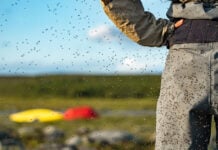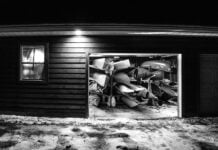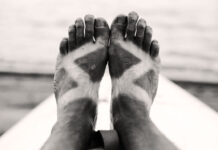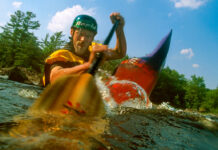We set out with two very different canoes.
Kate and I were test paddling a brand new carbon fiber epoxy-infused H2O Canoe Co. Prospector. With integrated composite gunwales it barely tipped the scales at 37 pounds. Despite it being a classic Chestnut Canoe Co. shape the construction is all state-of-the-art stealth fighter jet.
Dean, on the other hand, found his cedar strip at a yard sale. It was in need of much repair, some of which had been started and abandoned by the woman’s husband, who she admitted wasn’t such a handy fellow. This was Dean’s first canoe restoration and first foray into woodworking. Using Ted Moore’s book Canoecraft and the encouraging advice on wooden boat forums, over the course of three winters, Dean brought his stripper back to life.
Without really doing the math we chose a route down the Barron River on the east side of Algonquin Park. The river was low and the route leapfrogged over the dry rapid sections from flatwater pool to flatwater pool until we reached the deep and majestic Barron Canyon. Around the campfire we calculated we would paddle 23 kilometers, walk nine kilometers and drive 300 kilometers over the daylight-short weekend.
Growing up a truck driver’s son, I learned the value of having the right tools for the right job. Now I have a barn full of tools. I have whitewater tripping canoes, solo playboats, tandem whitewater slalom racing canoes, whitewater squirt C1, freestyle kayaks converted to C1s, and on the dock at the office I have a training shell for misty morning workouts.
Dean had invested a few hundred dollars into materials and wood working tools and too many hours of sweat equity. He built a steamer box and learned to bend new ash stems. He now knows just the right
amount of resin to apply with each sheet of fiberglass and he knows what three extra layers of varnish feels like after two trips over three back-to-back 600-meter carries.

NOT TOO FUSSY.| PHOTO: SCOTT MACGREGOR
There is a 29-pound weight difference between my stealth black Prospector and Dean’s cedar reno. By the end of the second day, I was teepeeing the canoe for Dean. I could still one-arm shoulder carry mine out of the water. On the steep rocky portage trails, Dean admitted to fantasizing about sexier composite canoes. On the water I appreciated the quiet natural beauty of his wooden labor of love.
This Paddling Buyer’s Guide is a 292-page tool catalog of dreams. On any given page you can complete the following sentence, “Now that would be perfect for…” Add in proper nouns, like the names of trips, rivers, waves or races, or substitute verbs, such as flying, lifting and carving.
We’ve UV coated the cover of this issue because readers tell me how their copies get ragged, dog eared and ringed from sweaty beer bottles and coffee cup stains. We like that. We know that shopping for gear is often the catalyst for grand adventures. We know you circle items and think to yourselves, if we had this we could go do that.
Don’t let worrying about the perfect purchase stop you from going. What Dean, Kate and I learned this fall is it didn’t matter much which boat we paddled. Our canoes were completely different yet both got the job done. I know that I probably had the perfect tool. But I also know that in a pinch you can fix many things with an old, rusty pair of Vise-Grip locking pliers. Sure, Dean’s shoulders were a little more tender but his stories in the office on Monday morning sounded just as good as mine.
Scott MacGregor is the founder and publisher of Rapid Media. He lives with his family in the Ottawa Valley.

Subscribe to Paddling Magazine and get 25 years of digital magazine archives including our legacy titles: Rapid, Adventure Kayak and Canoeroots.







